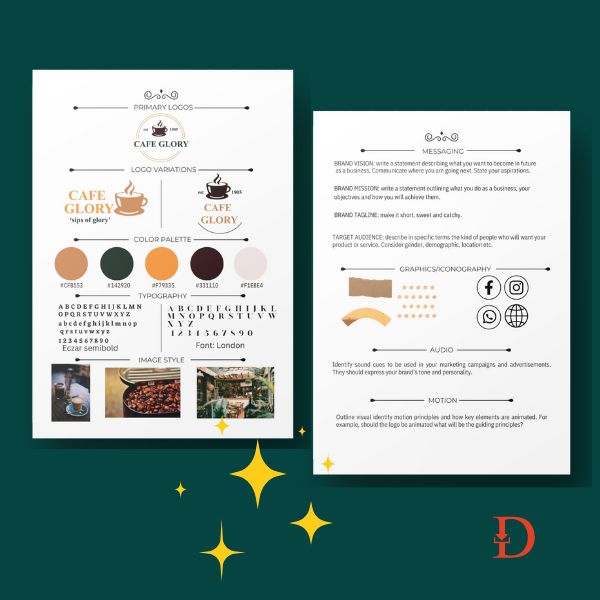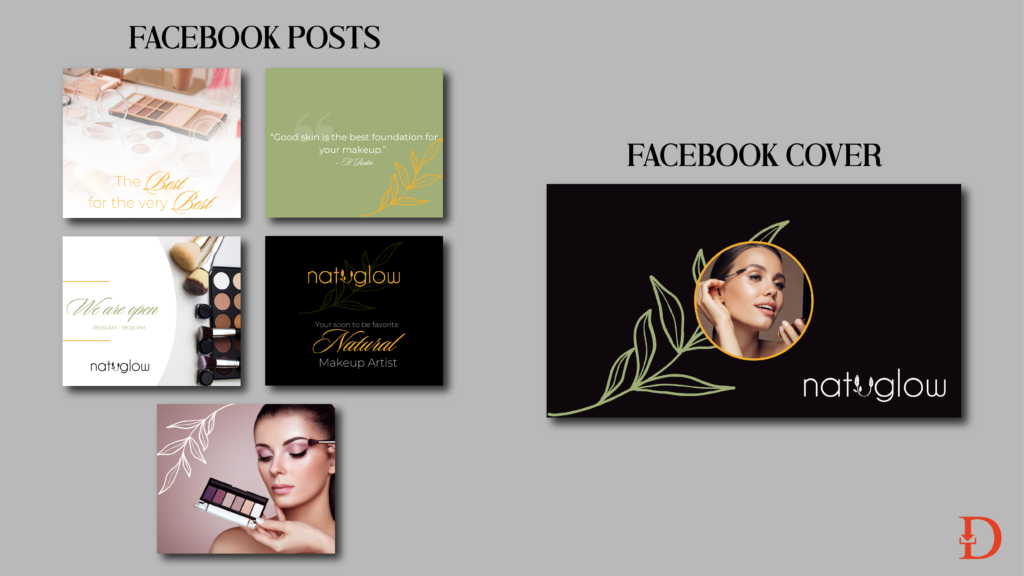A brand kit- also called a brand identity kit is a simple document that displays the non-negotiable standards of the visual elements of your brand. In other words, It is a collection of your company’s all-important visual assets and information.
The standards of these visual elements are non-negotiable as they tell your brand story as you want it told. A brand kit helps you avoid misrepresentation of your brand when other parties are creating content for you. Some of your brand’s visual elements are the logo, colour palettes, and assigned fonts.
So…you get wind of a new coffee shop in your neighbourhood via Instagram. Its beautifully designed feed that had templates in pleasant shades of brown and yellow colours instantly draw your attention. You are a coffee lover and without hesitation, you dash to sample their offer.
Enter the coffee shop. A minimalistic ambiance meets your eye. Quite relaxing.
The shop is meticulously painted in black and white with furniture to match. The smell of coffee and freshly baked pastries pull you in. You take your seat and a smiling waitress struts in your direction to hand you a leather-covered menu whose insert has been designed with a red, orange, and green colour palette.
Being one who is attentive to details, you realize something is off. But first, coffee!
Experts report that 55% of a business’s first impression comes from the visual elements -the look of the brand’s logo, its colour palette, and illustrations that match the brand’s tone. Any wonder why a brand kit is indispensable for your small business?
Whether you are a solopreneur, creator, or fully-fledged company, the importance of a brand kit for your brand cannot be overemphasized. It is a sure-fire way to be quickly recognized by your target audience. And isn’t that what good branding is all about?
Get to know the purpose of a brand kit, its components, how to use it, and how to make it accessible to your team or external partners.
Purpose of a Brand Kit
Firstly, the main purpose of a brand identity kit is to act as a reference point for you or your creative team. This helps maintain brand consistency in all your projects.
Why is this important? A brand that remains consistent with its target audience speaks of its perceived reliability and legitimacy. This in turn fuels trust, increases engagement, and ultimately increases your brand’s profitability.
A 2019 survey done by Edelman Trust barometer revealed that 81% of consumers make their purchasing decisions based on trust. Any serious brand cannot afford to choose its visual elements on a whim. A reference point is important and that is why a brand identity kit comes highly recommended.
Secondly, save your time. Having all design assets in a central place helps increase efficiency and ease in accessing the elements and applying them across your marketing materials, website, business templates, and messaging. Your new hire will not be generating the hex code you previously used nor will she be searching through hundreds of fonts every time you need your social posts done.
Thirdly, a brand kit will help anyone in your team or external parties with little to know design knowledge to apply the assets to their creatives with ease. You will be confident that your brand’s visual standards will be maintained no matter who designs the creatives.
Finally, your brand identity kit is the only sure way that your company will use to express itself and become memorable to its consumers. Beat your competition by staying on top of the mind of your target audience.
Components Of A Brand Kit

Several visual elements can be added to your brand kit. However, as shown in the template, pictured above ,the most business-critical assets should be made a priority.
Once you have identified your brand’s values and target audience, consider the following essentials:
- Logo: This is what makes your brand stand out from the rest. You can DIY a stunning logo that will be timeless and impactful. Ensure that it has variations of your colour scheme so that it can be printed on both dark and light-coloured surfaces.
- Colour profile: The Canva color generator is a great resource to pick the colour palette that best defines your brand and what it stands for. Take note of the hex codes of your colour choice to be added to your template. The RGB values will be used in your digital content while the CMYK values will be used for your print materials.
- Fonts: Your brand’s style and tone of voice will determine the kind of fonts to use. Pick two fonts that pair well. You can have a third font but not more than that.
- Image Style: Your brand’s personality will dictate the kind of illustrative elements you’ll use. It can be types of photos, illustrations, or artwork. For example, if your brand focuses on children’s attire then it will have whimsical illustrations that have delightful tones.
- Templates: A standard structure for how to create your templates will simplify work for your designers. The template for your business card, letterhead, invoice, receipt, thank you card, and social posts should have a structure that speaks of your brand identity.
More assets,
- Messaging
1. Brand vision: this is a statement of the direction your brand is taking and what it hopes to achieve in the future.
2. Brand mission: this is a statement to show how you aim to achieve your brand’s vision.
3. Brand values: list the attributes that your brand will be known for. These are values that you will uphold without compromise.
4. Brand tagline: write a short, sweet, and catchy phrase that will be memorable
5. Target audience: clearly define your target audience and the solution your brand offers it.
- Audio cues: identify sound cues to be used in your marketing campaigns and advertisements. They should express your brand’s tone and personality.
- Motion/Videos: outline visual identity motion principles and how key elements are animated. For example, should the logo be animated what will be the guiding principles?
- Graphics/Iconography: employ a style of graphics and icons that will feature consistently in your designs. Graphics such as shapes, backgrounds, and patterns should follow a particular theme. Will they be line art or 3D? For icons, choose a simple and clean set that can easily be scanned.
Granted, you would fill overwhelmed this far. You don’t know where or how to start in crafting these visual elements. Canva is a good place to start. A number of other online tools can be great resources for getting logos in recommended formats, more font ideas and vast libraries of photos.
Where to Create And Store Your Brand Visual Identity Kit
Canva Pro allows you to create and save not just one brand kit but multiple kits for your various campaigns on its platform. This ease of accessibility enables you or any other team member to use it whenever the need arises.

If you are using the free version, edit this free simple brand kit pdf template on Canva, save it on your computer, and share it with whoever needs it.
Building a business is not a walk in the park. It demands a considerable amount of your time and effort. That notwithstanding, building your brand kit has to be top on the list of priorities.
This second version of the brand kit template contains extra guidelines that you can edit to incorporate more details of your brand and what its about.
It should spare you some precious time.
Go on and build a winning brand kit!







